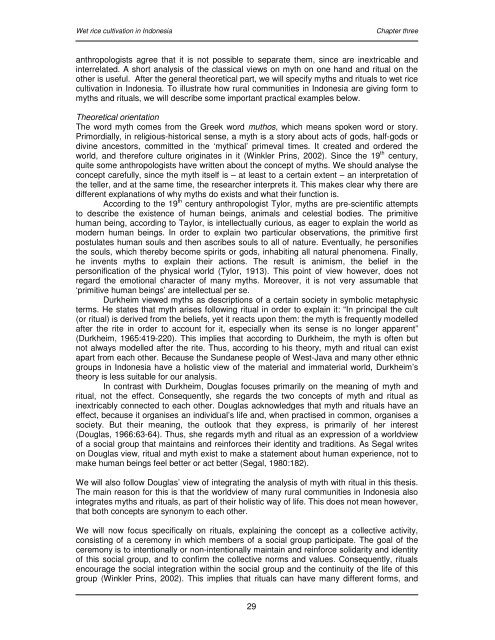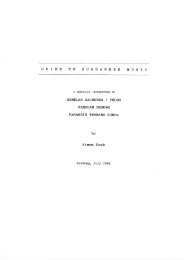Wet rice cultivation in Indonesia - Free EBooks Library
Wet rice cultivation in Indonesia - Free EBooks Library
Wet rice cultivation in Indonesia - Free EBooks Library
Create successful ePaper yourself
Turn your PDF publications into a flip-book with our unique Google optimized e-Paper software.
<strong>Wet</strong> <strong>rice</strong> <strong>cultivation</strong> <strong>in</strong> <strong>Indonesia</strong> Chapter three<br />
anthropologists agree that it is not possible to separate them, s<strong>in</strong>ce are <strong>in</strong>extricable and<br />
<strong>in</strong>terrelated. A short analysis of the classical views on myth on one hand and ritual on the<br />
other is useful. After the general theoretical part, we will specify myths and rituals to wet <strong>rice</strong><br />
<strong>cultivation</strong> <strong>in</strong> <strong>Indonesia</strong>. To illustrate how rural communities <strong>in</strong> <strong>Indonesia</strong> are giv<strong>in</strong>g form to<br />
myths and rituals, we will describe some important practical examples below.<br />
Theoretical orientation<br />
The word myth comes from the Greek word muthos, which means spoken word or story.<br />
Primordially, <strong>in</strong> religious-historical sense, a myth is a story about acts of gods, half-gods or<br />
div<strong>in</strong>e ancestors, committed <strong>in</strong> the ‘mythical’ primeval times. It created and ordered the<br />
world, and therefore culture orig<strong>in</strong>ates <strong>in</strong> it (W<strong>in</strong>kler Pr<strong>in</strong>s, 2002). S<strong>in</strong>ce the 19 th century,<br />
quite some anthropologists have written about the concept of myths. We should analyse the<br />
concept carefully, s<strong>in</strong>ce the myth itself is – at least to a certa<strong>in</strong> extent – an <strong>in</strong>terpretation of<br />
the teller, and at the same time, the researcher <strong>in</strong>terprets it. This makes clear why there are<br />
different explanations of why myths do exists and what their function is.<br />
Accord<strong>in</strong>g to the 19 th century anthropologist Tylor, myths are pre-scientific attempts<br />
to describe the existence of human be<strong>in</strong>gs, animals and celestial bodies. The primitive<br />
human be<strong>in</strong>g, accord<strong>in</strong>g to Taylor, is <strong>in</strong>tellectually curious, as eager to expla<strong>in</strong> the world as<br />
modern human be<strong>in</strong>gs. In order to expla<strong>in</strong> two particular observations, the primitive first<br />
postulates human souls and then ascribes souls to all of nature. Eventually, he personifies<br />
the souls, which thereby become spirits or gods, <strong>in</strong>habit<strong>in</strong>g all natural phenomena. F<strong>in</strong>ally,<br />
he <strong>in</strong>vents myths to expla<strong>in</strong> their actions. The result is animism, the belief <strong>in</strong> the<br />
personification of the physical world (Tylor, 1913). This po<strong>in</strong>t of view however, does not<br />
regard the emotional character of many myths. Moreover, it is not very assumable that<br />
‘primitive human be<strong>in</strong>gs’ are <strong>in</strong>tellectual per se.<br />
Durkheim viewed myths as descriptions of a certa<strong>in</strong> society <strong>in</strong> symbolic metaphysic<br />
terms. He states that myth arises follow<strong>in</strong>g ritual <strong>in</strong> order to expla<strong>in</strong> it: “In pr<strong>in</strong>cipal the cult<br />
(or ritual) is derived from the beliefs, yet it reacts upon them: the myth is frequently modelled<br />
after the rite <strong>in</strong> order to account for it, especially when its sense is no longer apparent”<br />
(Durkheim, 1965:419-220). This implies that accord<strong>in</strong>g to Durkheim, the myth is often but<br />
not always modelled after the rite. Thus, accord<strong>in</strong>g to his theory, myth and ritual can exist<br />
apart from each other. Because the Sundanese people of West-Java and many other ethnic<br />
groups <strong>in</strong> <strong>Indonesia</strong> have a holistic view of the material and immaterial world, Durkheim’s<br />
theory is less suitable for our analysis.<br />
In contrast with Durkheim, Douglas focuses primarily on the mean<strong>in</strong>g of myth and<br />
ritual, not the effect. Consequently, she regards the two concepts of myth and ritual as<br />
<strong>in</strong>extricably connected to each other. Douglas acknowledges that myth and rituals have an<br />
effect, because it organises an <strong>in</strong>dividual’s life and, when practised <strong>in</strong> common, organises a<br />
society. But their mean<strong>in</strong>g, the outlook that they express, is primarily of her <strong>in</strong>terest<br />
(Douglas, 1966:63-64). Thus, she regards myth and ritual as an expression of a worldview<br />
of a social group that ma<strong>in</strong>ta<strong>in</strong>s and re<strong>in</strong>forces their identity and traditions. As Segal writes<br />
on Douglas view, ritual and myth exist to make a statement about human experience, not to<br />
make human be<strong>in</strong>gs feel better or act better (Segal, 1980:182).<br />
We will also follow Douglas’ view of <strong>in</strong>tegrat<strong>in</strong>g the analysis of myth with ritual <strong>in</strong> this thesis.<br />
The ma<strong>in</strong> reason for this is that the worldview of many rural communities <strong>in</strong> <strong>Indonesia</strong> also<br />
<strong>in</strong>tegrates myths and rituals, as part of their holistic way of life. This does not mean however,<br />
that both concepts are synonym to each other.<br />
We will now focus specifically on rituals, expla<strong>in</strong><strong>in</strong>g the concept as a collective activity,<br />
consist<strong>in</strong>g of a ceremony <strong>in</strong> which members of a social group participate. The goal of the<br />
ceremony is to <strong>in</strong>tentionally or non-<strong>in</strong>tentionally ma<strong>in</strong>ta<strong>in</strong> and re<strong>in</strong>force solidarity and identity<br />
of this social group, and to confirm the collective norms and values. Consequently, rituals<br />
encourage the social <strong>in</strong>tegration with<strong>in</strong> the social group and the cont<strong>in</strong>uity of the life of this<br />
group (W<strong>in</strong>kler Pr<strong>in</strong>s, 2002). This implies that rituals can have many different forms, and<br />
29








